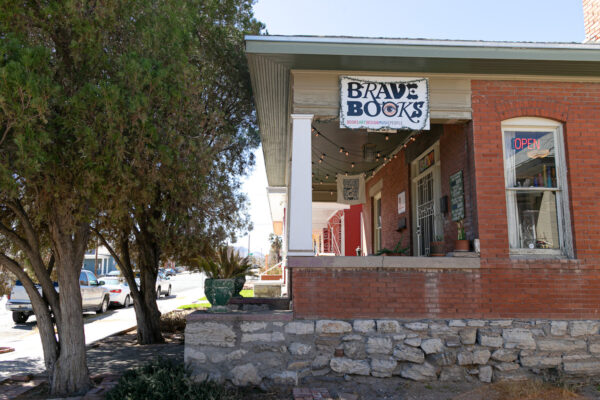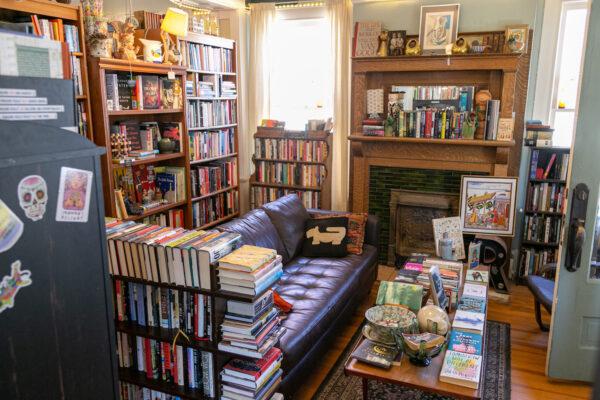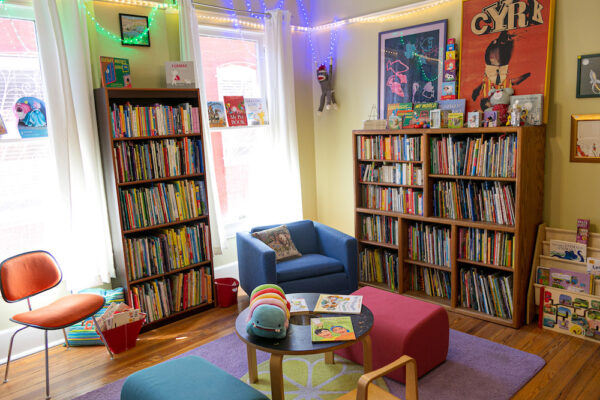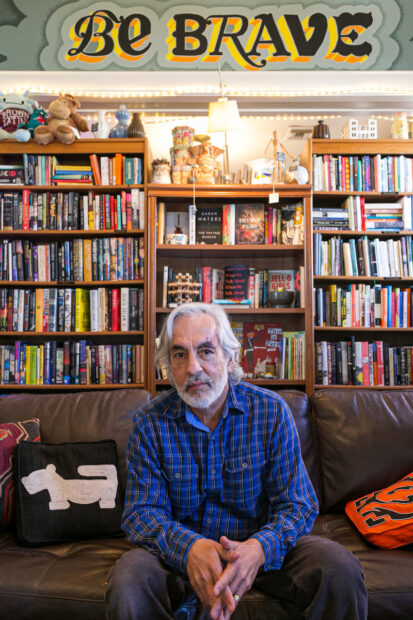
Jud Burgess in his bookstore, Brave Books, in front of a hand-painted sign by his daughter, Annabeth. Photo by Cody Bjornson.
This story is the second in a two-part series. To learn more about Juan Sandoval and his art collection, check out Part 1 here.
To read this story in Spanish, please go here.
Piled high in a garage in El Paso’s Austin Terrace Historic District are 300 cardboard boxes full of books, nearly touching the ceiling. They contain everything from Fabre’s Book of Insects, published in 1921, which features enchanting illustrations of insects underneath delicate layers of onion paper, to a limited edition James Joyce novel stuffed with old library cards, to a set of books titled The History of Colorado with swirling marbled edges.
“A librarian knows his books,” says Jud Burgess, local bookstore owner and graphic designer, as he gently unboxes the books for the first time, brushing dust off their jackets and combing over them with the trained eye of a collector. The treasure trove, housed in Burgess’ garage, has been passed down to his bookstore Brave Books by longtime University of Texas El Paso (UTEP) librarian and Mexican and Latinx art collector Juan Sandoval upon his passing in January 2021.
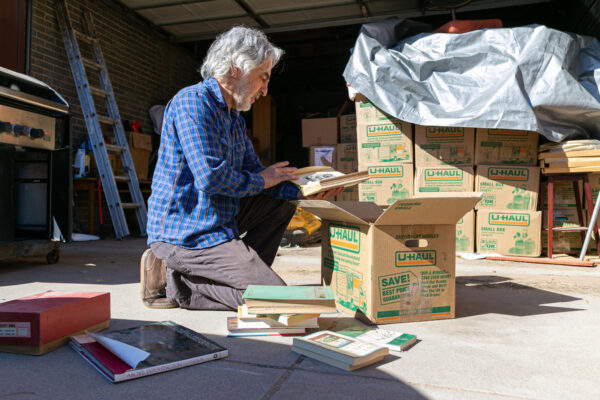
Jud Burgess unboxing books from Juan Sandoval’s collection for the first time. Photo by Cody Bjornson.
The books donated to Brave Books from Sandoval are the remaining texts from his collection, from which the Mexic-Arte Museum in Austin first selected books relating to Sandoval’s historic art collection which he gifted to the museum, now on view until August 22.
Sprinkled in with novels on art, book making, Japanese culture, and LGBTQ literature, to name a few subjects, are bits of ephemera including a letter addressed to Sandoval from the Society for Italic Handwriting, containing his membership card, and a WWII-era calligraphic guest book. Burgess first met Sandoval in El Paso in the ‘80s while taking photos around Sandoval’s apartment complex, The Palmore in Sunset Heights, on one of his first dates with his now-wife Laurie. Sandoval invited them up to his apartment for jasmine tea. Other than the occasional run in at art openings, the Burgesses were not frequently in contact with Sandoval, so the news that Brave Books would be the recipient of his extensive book collection came as a surprise.
“He was very under the radar, obviously. I mean, people knew about his art collection, because he invited a lot of people to go look at it. But a lot of that was in storage. So they really had no idea how big it really was. And with the books, I don’t think anybody had a clue,” says Burgess.

Laurie and Jud Burgess outside of their home in El Paso’s Austin Terrace Historic District. Photo by Cody Bjornson.
Burgess estimates Sandoval’s book collection totals more than 7,500 books — enough to open a stand-alone bookstore — and will take years to fully categorize and research. Brave Books is focusing its initial comb through on whether books are limited edition, signed, or connected to one of Sandoval’s common collection areas. Books about El Paso’s history, race relations, the Southwest, art, and LGBTQ topics are of special interest. Due to the sheer size of the gift and Brave Books’ capacity as a small local shop, the Burgesses will sell the majority of the collection. Only the priceless, rare books (Jud Burgess estimates there are several hundred) will be kept by the shop, which they plan to bring out for regular, public viewings. Embossed stamps will unify the collection, linking texts back to Brave Books and Sandoval, and informational bookmarks on Sandoval will be given out for free alongside books from his collection.
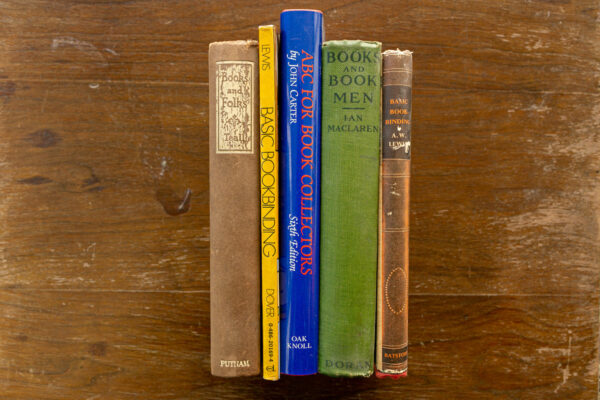
A sampling of books from Mexican and Latinx art collector Juan Sandoval’s personal collection. Photo by Cody Bjornson.
Of the few boxes Burgess dug into that sunny, brisk morning in mid-February during our interview, each book revealed a different aspect of Sandoval’s humanity, from historical books on the medieval era to a humorous bachelor’s guide to Japan. I began to get a sense of Sandoval as a person with immense intellectual curiosity and a democratic attitude. Online receipts folded in between book pages revealed Sandoval’s methods of acquisition. In his role as reference librarian and Chicanx studies point person, part of his job was to travel to book fairs to acquire new works for UTEP’s library.
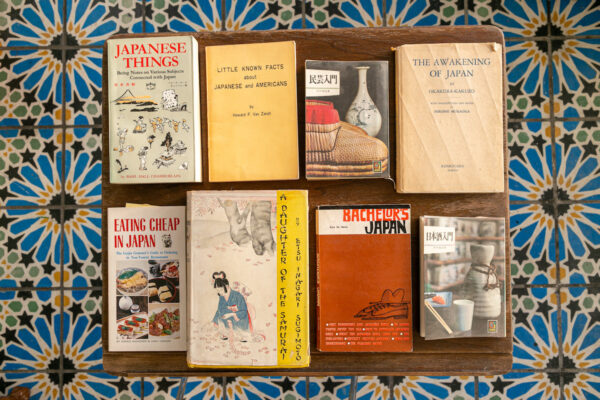
A sampling of books from Mexican and Latinx art collector Juan Sandoval’s personal collection. Photo by Cody Bjornson.
A Nixon presidential campaign portfolio designed by internationally renowned typographer Carl Hertzog (and published by the publishing branch of UTEP, Texas Western Press), and a copy of Am I Not Here, 1962, signed by Father Rahm, are among the notable finds on El Paso’s history. Father Rahm, known as the bicycling priest, launched gang- and youth-outreach programs and is a source of pride for El Paso, evident by the street named after him in the Segundo Barrio. Massive, late-1800s leather bound portfolios on Swiss symbolist painter Arnold Böcklin containing gravures of his work are other standouts.
Brave Books will open up a Juan Sandoval Room in its shop and encourage locals to choose books from Sandoval’s collection to add to their personal libraries. The Burgesses have chosen to share hundreds of rare books with the public over time, and hope they’re embraced as art objects — rather than sell them to the highest bidder, or keep them in storage where they’ll never see the light of day.
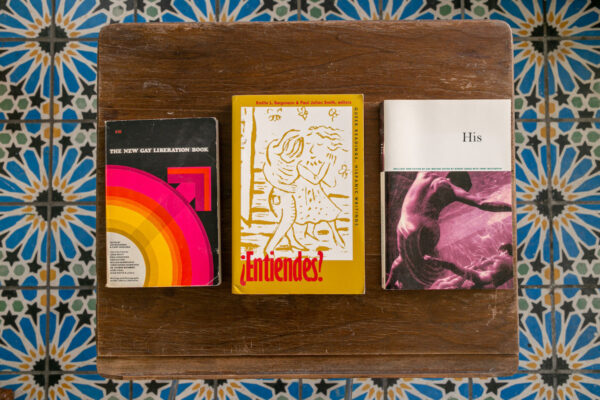
A sampling of books from Mexican and Latinx art collector Juan Sandoval’s personal collection. Photo by Cody Bjornson.
“I’d rather twenty people read this over three years than one person buy it and take it,” says Burgess. “I think in a way, showing this collection to people is going to inspire them to start their own collections. It perpetuates a love of books, because this is a reflection of [Sandoval’s] love of books, and our love of books, and we want to share that with El Paso.”
Jud Burgess, 60, is a native El Pasoan who has owned his own graphic design company, Substance, since 1988. He and his wife, Laurie, a speech pathologist, had long dreamed of opening a bookstore in El Paso and finally opened the doors to Brave Books in 2019. Decades ago, Jud began collecting graphic design, advertising, vintage and visual arts books to build up a self-education library for his business, which started his journey to becoming a book collector. He says he learned where to go for good deals and how to spot rare books.
“You don’t go to school to learn how to be a book dealer, or how to run a bookstore; you literally just have to get your location and start filling it up with books,” says Burgess.
And fill it up he has. Brave Books, a 1915 bungalow located in West Central El Paso, is a welcoming brick building on the outside, and explodes with warmth, music, books and art objects upon entry. The bookstore cat Yofi roams through the stacks and lounges with visitors on the eclectic mix of couches and chairs. The space is designed to encourage people to plop down and stay a while.
“I go to so many different places; I bring in a lot of vintage, antique, limited editions. I’m just out there getting all sorts of different types of books,” says Burgess. “So we have the whole gamut that serves — like I like to say — we serve ages two to ninety-nine.”
The people-oriented aspect of running a bookstore has always appealed to Burgess, who spent many years in his graphic design business working for a handful of clients. The mission of Brave Books is to help promote literacy in El Paso, one of the least literate cities in America. An 2014 article published in Time magazine states: “There were also less bookstores available to El Paso’s residents than in any other city last year. Low education rates of the city’s residents may partly explain the low demand for bookstores.” By offering free books on its porch, an entire room dedicated to children’s books, and more competitive prices than chain bookstores, Brave Books seeks to be accessible to El Paso residents and encourage them to dive into their personal interests through books.
“I’ll tell you what people don’t buy around here. They don’t buy business books. And they don’t buy biographies,” says Burgess. “People buy a lot of Latino because we are in an 83% Latino community on the border. So I’ve got an entire shelf dedicated to that. They buy Southwest, they buy classics, they buy vintage, they buy poetry.”
The shop’s children’s book room is outfitted with vibrant vintage toys and art. Classics like Goodnight Moon appeal to adults and children alike. Burgess’ ability to spot high quality illustration has resulted in a collection of graphically engaging, artistic children’s books. Laurie Burgess says one of the most important aspects of owning Brave Books is ensuring it serves as an educational space for children and their parents.
“My dream for part of the bookstore is pushing pre-literacy and literacy skills. I want people to come in with their kids to be able to learn how to parent better, actually; read to their kids, be a part of the picture of them developing and getting to know their own child better,” says Laurie.
In addition to providing recently published books at cheaper prices, Brave Books also specializes in vintage and rare books, often posting to the shop’s Instagram account to entice buyers. Sharing books online was a lifeline for the bookstore at the start of the pandemic. Jud Burgess posted, and then delivered books to people all over town before reopening the store for one-hour appointments. The fact that the Burgesses own Brave’s building and don’t have employees (Jud operates the shop) alleviates overhead costs that could have really hurt during the pandemic. Brave Books has experienced steady growth since opening in 2019, and Jud Burgess hasn’t slowed his book acquisition.
“My mom’s two-car garage is full of 20 bookshelves, all full of books. It’s like a bookstore within a two car-garage,” he laughs.
The Burgesses have the ambition to open a second bookstore with Brave’s overflow inventory, and incorporate more of Sandoval’s contributions there as well. Jud Burgess has sources that provide newer books and books of local interest; plus, he’s a big estate sale and thrift store junkie. He says it’s a big city with a lot of books, and Brave Books is becoming known for taking donations.
“It’s gotten to the point now where people know of us, and they call us up and say, ‘My grandmother was an artist, or my mother was an artist, and she had a great collection, we want to donate to your bookstore, because we feel your bookstore will be perpetuating her legacy or love of reading,’ which is kind of what happened with Juan. He knew we were going to be responsible with his books,” says Burgess.
The common thread connecting Jud Burgess with his customers is simply a love of and fascination with books. During my visit to the shop one Sunday afternoon, customers streamed in and out, browsing, making selections and catching up with Burgess as they checked out. He engages with everyone, commenting on the books they’ve chosen, sharing his knowledge, always learning about his customer base. A natural storyteller, Burgess often posts portraits of his customers with their books on Brave Books social media accounts, with a recap of their foray into the shop.
“A lot of people are finding out about Brave Books and are very surprised to see a little independent bookstore beginning to thrive,” says Carmen Rodriguez, a retired lawyer and longtime resident of El Paso. “I think anybody that loves books and finds out about it just falls in love with his bookstore.”
By making Sandoval’s book collection available to all El Pasoans, Brave Books intends to keep Sandoval’s presence in the community alive, although his art collection has moved to Austin and the Mexic-Arte Museum.
“As a locally owned bookstore, we don’t want to take advantage because he’s entrusted us with this. It’s a special gift that we feel very honored [to have received] and it’s our responsibility to keep his memory alive,” says Burgess. “And to share that with the community, the way his art should have been shared with the community and wasn’t.”
Jud Burgess has been deeply involved in local politics for years, writing a column for the El Paso Times and running a campaign for city council in 2017. He says while he does not doubt the Mexic-Arte in Austin will be responsible stewards of Sandoval’s art collection, he feels it was a real shame to see it leave El Paso.
“The city lost a golden opportunity to put us on the map. El Paso really should be the Latino cultural capital of not just Texas, but America. Because of our history, our culture and everything,” Burgess says. “[Sandoval] would have been more than happy to gift it to us if we had shown initiative, but people just didn’t. So he basically found somebody that was going to respect that collection, and that was Austin — the Mexic-Arte Museum.”
Burgess says the city of El Paso’s decision — more specifically the Museum and Cultural Affairs Department — to not acquire Sandoval’s historic Mexican and Latinx art collection reflects the city government’s ongoing lack of support for local arts. The controversy over the 2012 Quality of Life Bond, which allocated millions of dollars for a yet-to-be-built Mexican American Cultural Center — along with improvements to the public library and the construction of a multipurpose arena — have also affected the fate of Sandoval’s art collection.
“The leaders have always been very short-sighted; they’re more interested in serving the people that line their campaign war chests. They’re all about bigger and better, ‘Let’s get a giant soccer stadium or baseball field that will lose money all the time,’ instead of little places like ours, and the kind of thing that really makes El Paso what El Paso is,” says Burgess. “What happened there is they really didn’t have the vision to create a place that would allow Juan’s amazing, world-class Latino art collection to be the cornerstone of a Latino Cultural Center.”
Local disapproval of the way the Quality of Life Bond was to be spent was exacerbated when the city proposed incorporating the cultural center into the public library, which Jud Burgess protested at a city council meeting, where he ultimately was arrested for interrupting the proceedings.
The Burgesses and many other El Pasoans have advocated for more focus on El Paso’s local heritage, geography and culture, versus farming out city art projects to artists from bigger cultural hubs.
“Instead of appreciating the vernacular that we have here, the very specific Latino, Chicano, artists, and people that give us our heritage and incorporate that into their art, they’ll import somebody from New York or Seattle, and give them a 24-hour lesson in culture. And then these people are supposed to kind of come up with artwork that’s gonna represent us,” says Burgess. “It never does.”
The still-undecided fate of the Mexican American Cultural Center has been tough for community members in El Paso who care about building the city’s reputation as a valued arts contributor, says Carmen Rodriguez.
“I think that heritage tourism just hasn’t clicked for people; how easy it would be if we just dressed up our cultural assets a little bit and promoted them,” says Rodriguez.
Rodriguez, who was a part of the Chicano Movement in the ‘70s and has spent her law career working in civil rights, says the incident has led to increased public discussion about the city’s historic lack of commitment to the Latinx community more broadly.
“A lot of people are realizing that there is contempt, there is racism, there is disrespect,” says Rodriguez. “The people that finance a lot of the projects that are developers, the financial institutions — we always talk about El Paso being 85% Mexican American, and if you were just to look at the financial world, the economic world that operates in El Paso, it would be the complete reverse. We have very little economic power.”
Many factors, including the city’s decision to tear down the old City Hall in order to put up a new baseball stadium, where tickets are unaffordable for many locals, have led to distrust in the local government. Rodriguez says, considering that the city controls the local museums and cultural institutions, it seems to do the bare minimum. Due to its distance from the rest of Texas, Rodriguez says, regrettably, El Paso is not of interest to many Texans, but the city stands between the state and the rest of the Southwest, and could act as a celebrated center point for travel.
“We feel like we are the center of a lot of art and culture that is just here organically, without much support from the powers that be. But there is still a lot going on with just community music and art,” says Rodriguez. “People like Jud, and a lot of people that we know, are trying to change things and trying to make it more real so that there is more support from the public entities for community art.”
Local arts advocates and emerging haunts like Brave Books hold the rekindling cultural torch of the border city. Sandoval’s legacy of education through books and art is reflected in the mission of the Burgesses, who will continue to sling paperbacks and attract a variety of readers with their welcoming space and badass books.
“Books are more than something you cram into a little computer in your hand. You can put them in your bookcase, show them off to your friends, loan them out, enjoy the artwork on the covers, take them to the coffee shop, and people know what you’re reading. Whereas if you’re on a phone, you’re just another person with your nose stuck in a phone,” says Burgess.


